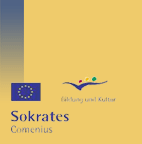|
Where: Group area, laboratory, small room
|
How long? Approx. 40 minutes
|
What? Explore the question: through
which materials can the magnetic force-field penetrate?
|
|
Preparation:
Wooden plate, aquarium
filled with water (jacked up on stones). For
each child: Magnets, iron
ball, wine cork, screw, toothpick, paper, glue, scissors.
|
Steps: The nursery school teacher briefly repeats
what the children have learned about magnetic and
non-magnetic materials.
He / She shows the children
the following "trick": An iron ball is held and moved on a piece of
wood with a magnet on the other side. The children speculate about how that works. They try it out. Afterwards
they look for an explanation. Now the children are asked to look for
different materials in the room (the kindergarten) which the magnetic
force-field penetrates.
The results are collected
and presented.
The nursery school teacher
lets a self-made boat swim (a cork with a screw and a sail made of a
toothpick and paper) in the jacked up aquarium. He / She gives the children a
magnet and asks them to steer the boat or to let it float. The children try
it out and discover that the boat can be steered through the wall of the
aquarium.
After this the children may
build their own boats and let them "swim".
Note: In free play the children can experiment
further.
|
|
Scientific explanation: The magnetic force-field penetrates
different materials and water.
The strength of the magnetic field depends on the thickness of the material
and on the strength of the magnet.
|
Possible variation: The experiment can be also be conducted with
a flat glass bowl.
|
|
Note! There are many good activities that the children
can try out to apply and consolidate the acquired knowledge. Instructions for
games and constructions can be found in the literature mentioned below..
|
References:
Ardey, Neill: Spannende Experimente aus Natur- und
Technik. Bindlach 1998
Lichtenberger, J: Löwenzahn Neues aus Technik und Umwelt. München 2002.
|











